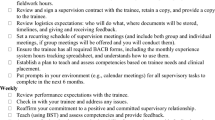Abstract
Nearly 1,000 professions are regulated in one or more of the 50 states. Behavior analysis is not regulated as a distinct profession except in Florida. Typically, the regulation of behavior analysis is subsumed within other professions (such as psychology) whose practices often differ considerably from those of behavior analysis. This paper provides an overview of the common methods of regulation and discusses the pros and cons of regulating behavior analysis independently of other professions. It also describes how one state agency in Florida has regulated behavior analysts through the Behavior Analysis Certification Program, with a historical summary of the development of the training curriculum and certification examination and description of current efforts to refine and expand the regulation of behavior analysts. Suggestions for establishing formal regulation of behavior analysts in other states are also given.
Similar content being viewed by others
References
Abramson v. Gonzales, 949 F.2d 1567 (11th Cir. 1992).
Agras, W. S. (1973). Toward the certification of behavior therapist. Journal of Applied Behavior Analysis, 6, 167–173.
American Educational Research Association, American Psychological Association, & National Council on Measurement in Education. (1985). Standards for educational and psychological testing. Washington, DC: American Psychological Association.
American Occupational Therapy Association. (1988). Handbook on state regulation of occupational therapy. Washington, DC: Author.
Begun, J. W. (1981). Professionalism and the public interest: Price and quantity in optometry. Cambridge, MA: MIT Press.
Boulier, B. L. (1980). An empirical examination of the influence of licensure and licensure reform on geographical distribution of dentists. In S. Rottenberg (Ed.), Occupational licensure and regulation (pp. 73–97). Washington, DC: American Enterprise Institute.
Carroll, S. L., & Gaston, R. J. (1981). Occupational restrictions and the quality of service received: Some evidence. Southern Economic Journal, 47, 959–976.
Cathcart, J. A., & Graff, G. (1978). Occupational licensing: Factoring it out. Pacific Law Review, 9, 147–163.
Dietz, S. M. (1978). Current status of applied behavior analysis: Sciences versus technology. American Psychologist, 33, 805–814.
Durant, W. C. (1987). Foreword. In S. D. Young (Ed.), The rule of experts: Occupational licensing in America (pp. x–ix). Washington, DC: CATO Institute.
Hayes, S. C., Rincover, A., & Solnick, J. V. (1980). The technical drift of applied behavior analysis. Journal of Applied Behavior Analysis, 13, 275–285.
Hogan, D. B. (1979). The regulation of psychotherapists (Vol. 1). Cambridge, MA: Ballinger.
Institute of Medicine. (1989). Allied health services: Avoiding crises. Washington, DC: National Academy Press.
Johnston, J. M., & Shook, G. L. (1987). Developing behavior analysis at the state level. The Behavior Analyst, 10, 199–233.
Kane, M. T. (1982). The validity of licensure examinations. American Psychologist, 57, 911–918.
Kleiner, M. M., Gay, R. S., & Greene, B. A. (1982). Barriers to labor migration: The case of occupational licensing. Industrial Relations, 21, 383–391.
Martin, S. (1982). An examination of the economic side effects of the state licensing of pharmacists. Unpublished doctoral dissertation. University of Tennessee, Knoxville.
Maurizi, A. (1974). Occupational licensing and the public interest. Journal of Political Economy, 82, 399–413.
Maurizi, A. (1980). The impact of regulation on quality: The case of California contractors. In S. Rottenberg (Ed.), Occupational licensure and regulation (pp. 26–35). Washington, DC: American Enterprise Institute.
McChesney, F. S., & Murris, T. J. (1979). The effect of advertising on the quality of legal services. American Bar Association Journal, 65, 1503–1506.
Michael, J. L. (1980). The flight from behavior analysis. The Behavior Analyst, 3, 1–21.
Muzondo, T. R., & Pazderka, B. (1980). Occupational licensing and professional income in Canada. Canadian Journal of Economics, 13, 659–667.
Pazderka, B., & Muzondo, T. R. (1983). The consumer costs of professional licensing restrictions in Canada and some policy alternatives. Journal of Consumer Policy, 6, 55–75.
Perloff, J. M. (1980). The impact of licensing laws on wage changes in the construction industry. Journal of Law and Economics, 23, 409–428.
Pierce, W. D., & Epling, W. F. (1980). What happened to the analysis in applied behavior analysis? The Behavior Analyst, 3, 1–9.
Poling, A., Picker, M., Grosset, D., & Hall-Johnson, E. (1981). The schism between experimental and applied behavior analysis: Is it real and who cares? The Behavior Analyst, 4, 93–102.
Pratt, L. J. (1980). Occupational licensing and interstate mobility. Business Economics, 15, 78–80.
Shepard, L. (1978). Licensing restrictions and the cost of dental care. Journal of Law and Economics, 21, 187–201.
U.S. Department of Health, Education, and Welfare. (1971). Licensure and related health personnel credentialing (No. 1720–0034). Washington, DC: U.S. Goverment Printing Office.
White, W. D. (1978). The impact of occupational licensure on clinical laboratory personnel. Journal of Human Resources, 13, 91–102.
Young, S. D. (1987). The rule of experts: Occupational licensing in America. Washington, DC: Cato Institute.
Author information
Authors and Affiliations
Rights and permissions
About this article
Cite this article
Starin, S., Hemingway, M. & Hartsfield, F. Credentialing Behavior Analysts and the Florida Behavior Analysis Certification Program. BEHAV ANALYST 16, 153–166 (1993). https://doi.org/10.1007/BF03392620
Published:
Issue Date:
DOI: https://doi.org/10.1007/BF03392620



